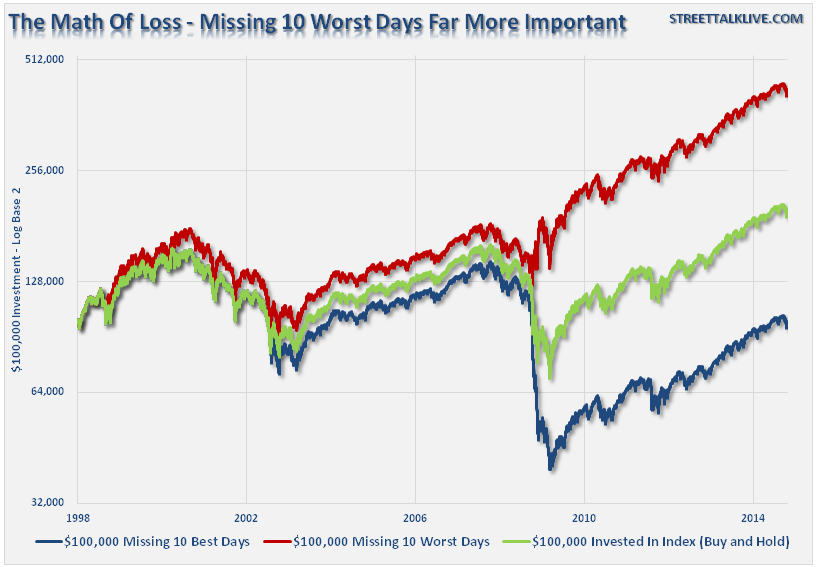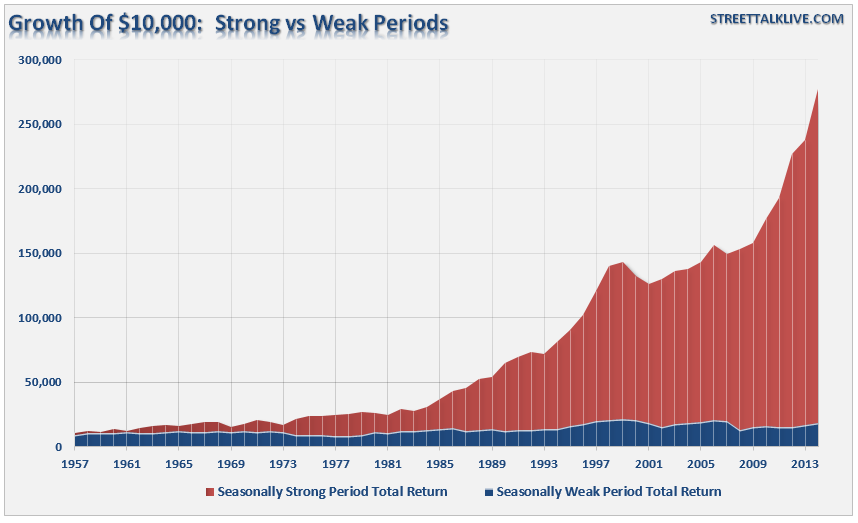Over the weekend, Sam Ro at Business Insider wrote The Truth About 'Sell In May And Go Away, stating:
"It's May. And one of the oldest 'rules' on Wall Street is 'sell in May and go away.'
Based on some rough historical observations, someone decided that it might be a great idea to stay out of the stock market between May and sometime in the fall. The truth is that the market doesn't tank during that period. Returns are just lackluster, not negative."
The article goes on to discuss analysis by FBN Securities' JC O'Hara who ran numbers for the past 20 years. In my opinion, twenty years of history is too short of a time-frame to properly analyze the historical tendencies of the markets particularly given the impact of Central Bank interventions over more than a quarter of that time frame.
Therefore, using the monthly data provided by Dr. Robert Shiller, let's take a look at the seasonally strong versus weak periods of the year going back to 1900. The table below, which provides the basis for the rest of this missive, is the monthly return data from 1900-present.
Using the data above, let's take a look at what we might expect for the month of May.
Historically, May is the 4th WORST performing month for stocks with an average return of just 0.26%. However, it is the 3rd worst-performing month on a media return basis of just 0.49%.
(Interesting note: As you will notice in the table above and chart below, average returns are heavily skewed by outlier events. For example, while October is considered the "worst month" with an average return of -0.32%, the median return is actually a positive 0.39% which makes it just the 2nd worst performing month of the year beating out February [the worst].)
As noted, May represents the beginning of the "seasonally weak" period for stocks. As the markets roll into the early summer months May, and June, tend to be some of weakest months of the year along with September. This is where the old adage of "Sell In May" is derived from. Of course, while not every summer period has been a dud, history does show that being invested during summer months is a "hit or miss" bet at best.
Like October, May's monthly average is also skewed by sharply negative returns during the "Great Depression." However, in more recent years returns have been primarily contained, with only a couple of exceptions, within a +/- 5% return band as shown below.
However, before you slip into a warm bath of investment bliss, it is important to remember that just because the data suggests that May will "probably" be a weak return month for the market, there is also the "possibility" it will not. The chart below depicts the number of positive and negative returns for the market by month. With a ratio of 53 losing months to 62 positive ones, there is a 46% chance that May will yield a negative return.
No Reason To Sell Just Yet
So, based on this historical evidence it would certainly seem prudent to "bail" on the markets, right? Maybe not. The problem with statistical analysis is that we are measuring the historical odds of an event occurring in the near future. Like playing a hand of poker, the odds of drawing to an inside straight are astronomically high against success. However, it doesn't mean that it can't happen.
Currently, the study of current price action suggests that the markets will likely break out to new highs in the days ahead. Such action, should it occur, will continue to support the "bullish case" for equities for now. This is why, as I have reiterated in our weekly missive, that portfolio allocations should remain biased toward equities. To wit:
"That breakout confirms the current bullish trend which suggests that allocation models remain tilted more heavily towards equity exposure for the current time. This will not ALWAYS be the case, therefore it is important to continue to pay attention to your money.
While there is currently no need to make any adjustments to the portfolio allocation model, there is sufficient warning signs to suggest that rebalancing portfolios makes sense."
And again in Remain Invested But Pay Attention To Warning Signs.
"The negative divergence of the markets from economic strength and momentum are simply warning signs and do not currently suggest becoming grossly underweight equity exposure. However, warning signs exist for a reason, and much like Wyle E. Coyote chasing the Roadrunner, not paying attention to the signs has tended to have rather severe consequences."
However, the "risk" to investors is not the possibility of a continued rise in the markets, but the risk of a sharp decline. As discussed in The Math Of Loss:
"The reason that portfolio risk management is so crucial is that it is not "missing the 10-best days" that is important, it is "missing the 10-worst days." The chart below shows the comparison of $100,000 invested in the S&P 500 Index (log scale base 2) and the return when adjusted for missing the 10 best and worst days."
"Clearly, avoiding major draw downs in the market is key to long-term investment success. If I am not spending the bulk of my time making up previous losses in my portfolio, I spend more time compounding my invested dollars towards my long term goals."
Since our job, as investors, is to compound our investment over time, the REAL RISK is NOT MISSING UPSIDE in the markets, but CAPTURING DECLINES. The destruction of investment capital is far more damaging to long-term investment goals than simply missing a potential for rather limited gains at this very late juncture of the investment market cycle.
The chart below shows the gain of $10,000 invested since 1957 in the S&P 500 index during the seasonally strong period (November through April) as opposed to the seasonally weak period (May through October).
It is quite clear that there is little advantage to be gained by being aggressively allocated during the summer months. However, in reality, there are few individuals that can maintain a strict discipline of only investing during seasonally strong periods consistently. Also, time frames of when you start and when you need your capital for retirement make HUGE differences in actual performance.
That is why, for investors, while the data is certainly interesting, it yields little. The problem remains that from market action simply cannot be anticipated with any given degree of certainty from one day to the next. No one has that answer. What we do know, is that eventually prices will take a turn for the worse and history shows that there will be little warning, fanfare or acknowledgment that something has changed. As the trend reverses, it will initially be met with denial, followed by hope, and ultimately acknowledgement, but only well after the fact.
With our portfolios fully invested at the current time, it makes little sense to focus on what could go right. You can readily find that case in the mainstream media which is biased by its needs for advertisers and ratings. However, by understanding the impact to portfolios when something goes "wrong" is inherently more important. If the market rises, terrific. It is when markets decline that we truly understand the "risk" that we take. A missed opportunity is easily replaced. However, a willful disregard of "risk" will inherently lead to the destruction of the two most precious and finite assets that all investors possess – capital and time.







